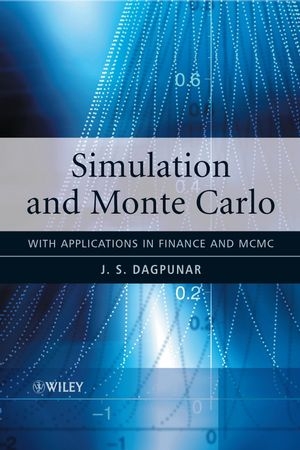
Simulation and Monte Carlo
John Wiley & Sons Inc (Verlag)
9780470854952 (ISBN)
Simulation and Monte Carlo is aimed at students studying for degrees in Mathematics, Statistics, Financial Mathematics, Operational Research, Computer Science, and allied subjects, who wish an up-to-date account of the theory and practice of Simulation. Its distinguishing features are in-depth accounts of the theory of Simulation, including the important topic of variance reduction techniques, together with illustrative applications in Financial Mathematics, Markov chain Monte Carlo, and Discrete Event Simulation. Each chapter contains a good selection of exercises and solutions with an accompanying appendix comprising a Maple worksheet containing simulation procedures. The worksheets can also be downloaded from the web site supporting the book. This encourages readers to adopt a hands-on approach in the effective design of simulation experiments.
Arising from a course taught at Edinburgh University over several years, the book will also appeal to practitioners working in the finance industry, statistics and operations research.
J. S. Dagpunar is the author of Simulation and Monte Carlo: With Applications in Finance and MCMC, published by Wiley.
Preface. Glossary.
1 Introduction to simulation and Monte Carlo.
1.1 Evaluating a definite integral.
1.2 Monte Carlo is integral estimation.
1.3 An example.
1.4 A simulation using Maple.
1.5 Problems.
2 Uniform random numbers.
2.1 Linear congruential generators.
2.2 Theoretical tests for random numbers.
2.3 Shuffled generator.
2.4 Empirical tests.
2.5 Combinations of generators.
2.6 The seed(s) in a random number generator.
2.7 Problems.
3 General methods for generating random variates.
3.1 Inversion of the cumulative distribution function.
3.2 Envelope rejection.
3.3 Ratio of uniforms method.
3.4 Adaptive rejection sampling.
3.5 Problems.
4 Generation of variates from standard distributions.
4.1 Standard normal distribution.
4.2 Lognormal distribution.
4.3 Bivariate normal density.
4.4 Gamma distribution.
4.5 Beta distribution.
4.6 Chi-squared distribution.
4.7 Student’s t distribution.
4.8 Generalized inverse Gaussian distribution.
4.9 Poisson distribution.
4.10 Binomial distribution.
4.11 Negative binomial distribution.
4.12 Problems.
5 Variance reduction.
5.1 Antithetic variates.
5.2 Importance sampling.
5.3 Stratified sampling.
5.4 Control variates.
5.5 Conditional Monte Carlo.
5.6 Problems.
6 Simulation and finance.
6.1 Brownian motion.
6.2 Asset price movements.
6.3 Pricing simple derivatives and options.
6.4 Asian options.
6.5 Basket options.
6.6 Stochastic volatility.
6.7 Problems.
7 Discrete event simulation.
7.1 Poisson process.
7.2 Time-dependent Poisson process.
7.3 Poisson processes in the plane.
7.4 Markov chains.
7.5 Regenerative analysis.
7.6 Simulating a G/G/1 queueing system using the three-phase method.
7.7 Simulating a hospital ward.
7.8 Problems.
8 Markov chain Monte Carlo.
8.1 Bayesian statistics.
8.2 Markov chains and the Metropolis–Hastings (MH) algorithm.
8.3 Reliability inference using an independence sampler.
8.4 Single component Metropolis–Hastings and Gibbs sampling.
8.5 Other aspects of Gibbs sampling.
8.6 Problems.
9 Solutions.
9.1 Solutions 1.
9.2 Solutions 2.
9.3 Solutions 3.
9.4 Solutions 4.
9.5 Solutions 5.
9.6 Solutions 6.
9.7 Solutions 7.
9.8 Solutions 8.
Appendix 1: Solutions to problems in Chapter 1.
Appendix 2: Random Number Generators.
Appendix 3: Computations of acceptance probabilities.
Appendix 4: Random variate generators (standard distributions).
Appendix 5: Variance Reduction.
Appendix 6: Simulation and Finance.
Appendix 7: Discrete event simulation.
Appendix 8: Markov chain Monte Carlo.
References.
Index.
| Erscheint lt. Verlag | 1.3.2007 |
|---|---|
| Reihe/Serie | Wiley Series in Probability and Statistics |
| Verlagsort | New York |
| Sprache | englisch |
| Maße | 170 x 244 mm |
| Gewicht | 595 g |
| Themenwelt | Mathematik / Informatik ► Mathematik ► Wahrscheinlichkeit / Kombinatorik |
| ISBN-13 | 9780470854952 / 9780470854952 |
| Zustand | Neuware |
| Informationen gemäß Produktsicherheitsverordnung (GPSR) | |
| Haben Sie eine Frage zum Produkt? |
aus dem Bereich


